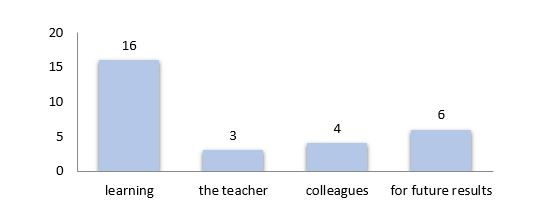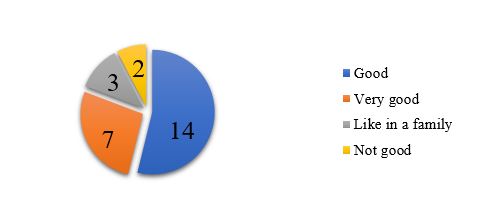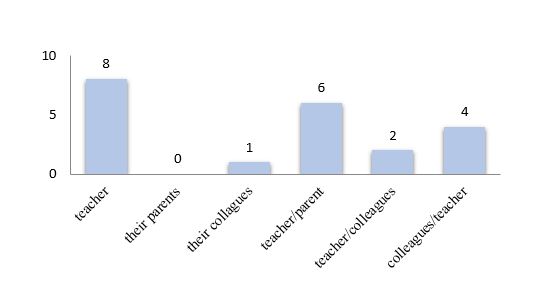Abstract
In the context of forming the emotional dimension of identity in children in society and sharing knowledge teachers have a great responsibility. Primary school teachers should have the necessary acquired skills to be leaders of their classroom but also to be mentors for the social and emotional dimensions of the child leading to a well-balanced citizen. When children get into the classroom they expect a warming and welcoming environment. This task falls mostly into the creative ability of the teacher who contributes to a positive classroom atmosphere very important for an optimal educational process. Thus a secure classroom can transform the child and with a positive teacher-student relationship he can better engage in learning activities. Most children in the Romanian school system view the classroom as their second home but this dimension is limited by the educational system’s agenda that has a greater influence in the teacher-student relationship. This study focuses on the experiences that third grade pupils had learning in a classroom specific to the public educational system in Romania. We tried to find out more about their learning experience, thoughts and feelings towards their teacher and colleagues in concern with different approaches to the usual ones of the teacher-student learning process. For the purpose of this study we designed a questionnaire and asked the children directly about their thoughts and experiences. The results indicated that children view their teacher as a factor in their wellbeing in the school environment.
Keywords: Emotional dimensionsocio-emotional developmentteacher-student relationshiplearning experiences
Introduction
Children’s social and emotional dimension
Children’s social and emotional well-being is closely related to their perception and interaction with their inside and outside world. Starting with late childhood, which coincides with the beginning of the school years, children tend to have an abstract attitude towards their emotions and they can adapt and control their emotions (Schaffer, 2010). Emotional development is closely related to both biological and social systems that are in an intertwined change and propose everyday challenges for which the child must find the appropriate tools to solve (Lozada & Halberstadt, 2015).The expression of an emotion incorporates a series of components including physiological and cognitive, behaviour and control (Seth-Smith, 2006). Schaffer (2010) states that young children are capable of using processes to operate with their own emotions and manage other children’s emotions. This can be useful in the early years of the school period when children are challenged with a series of social interactions that require a strong mechanism for adjustment. A well balanced development in early childhood is a key component in assuring that the child has the proper means for interacting with his peers and other children in the formal environment. When faced with the challenges of social and learning nature the child must be prepared to control and manage his emotions in his advantage.
New tasks are always a good opportunity for the child to learn and develop a sense of his own reactions to different school situations. Accomplishments from the previous periods of his life (e.g. kindergarten) are building blocks for a good transition to the next level of social and emotional development (Denham & Brown, 2010). The authors also state that the social and emotional development that accompany one stage of a child’s life differs in terms of success rates and we can say that this will always be in a continuous improvement as the child progresses with his scholastic path. Through recognizing and understanding their own emotions children recognize a greater effect that this has towards their own and other’s emotions. This is possible with exercising emotional awareness and the child will begin to better understand the world around him through interpersonal interactions. One study found that there are differences between the development of self-awareness and social skills in fourth graders and second graders (Tarasova, 2018). They further concluded that the differences in other components of emotional development are not statistically significant, but in older children there are different changes in the way they interact with peers and adults. The social context differs for these children and they grow accustomed to interactions that are challenging and their emotional development responds to these changes.
Teachers responsibilities
Teacher’s previous school training is an important component in creating the best school environment for the children that are entering into primary levels of education. Starting with the early stages of childcare the teachers are responsible for providing a nurturing and healthy environment for the children and this is important for their well-being. Study finds that teachers training in early childcare programs provide support for the teacher and assure that the children benefit from a qualitative learning experience (Lin & Magnuson, 2018). The authors agreed that formal education is vital but requirement for BA or MA degree is not a necessity but in some cases a formality. We must agree that higher training programs offer the proper courses for the development of teacher’s skills but without engagement from the student the future teacher may not achieve his true potential and may never truly embrace the teacher’s way of providing the best learning experience for the children.
Conflicts that appear in the classroom may cause lower levels of achievements in executive functions, reading and math levels (McKinnon & Blair, 2018). The more conflictual the child is in the classroom the less are the levels of reading and he may not find the learning experience pleasant. This is not a bidirectional relationship. The teacher will never have a conflict with a student or a child if he is a professional. The entirety of the resolution for the conflict relies on the teacher’s skills of classroom management and communication. He must try to resolute the conflict at the micro pedagogical level and if he fails he must address other competent colleagues such as the school counsellor. Partnerships between the teacher and the parents are an important component in classroom management (Manea, 2015) and the teacher must initiate this kind of liaison for a better cooperation between the parents and the school and also implicating the parents in classroom management.
In the classroom environment teachers are faced with challenges everyday and they have to be prepared emotionally for the sometimes overwhelming tasks. Teacher can promote children’s cognitive functioning by guiding them to be independent in their school work, to focus on the environment on the classroom and its dynamics and offer them means of overcoming difficult tasks (Gassera, Grüttera, Buholzera, & Wettsteinb, 2018). The authors further agree that the levels of dependency of the children predict the development of some components of working memory. To some extend the type of communication and exchange can further influence the child’s emotional development informing future liaison with his peers. Children’s emotional engagement is a stable construct as predicted by Ulmanena and colleagues (2016) and is in close relation with their engagement with peers and teachers. The authors also concluded that past experiences influence the quality of future teacher-student associations. This would translate that the children form a very powerful bond with their teachers and the way they view these associations will follow them into their academic lives. In this context the teachers have an important responsibility for creating the best scenarios in the classroom and providing meaningful and healthy feedback for a learning experience for the child.
Problem Statement
When we have a trained teacher in charge of a classroom with all the requirements needed we have a convenient learning experience. A devoted teacher can make a classroom stand out and the learning experiences can be in the advantage of the children. The teacher must be dedicated and qualified for offering the children a suitable emotional and intellectual support.
Research Questions
According to the research question we expected to find the way children view their learning experience and their association with their teacher in the classroom. One main interest was the impact the learning environment offered by the teacher has on children and how it affects them during school classes and how children deal with interferences caused by different factors such as classroom arrangement and also positive and negative conditions provided.
Purpose of the Study
The current paper tried to establish the emotional and social aspect in primary school children that are vital for children’s well-being. We have studied children’s feedback to the questionnaire and identified factors that impact their interactions with their peers and their learning experience
Research Methods
Participants
The participants to this study were 21 primary school children (Nfemale=7, Nmale=14) enrolled in the third grade a school in Cluj-Napoca, Romania with the age between 9 and 10 (Mage=9.09).
Design
An open-ended interview was designed to better understand the views of the children. The interview had ten questions (includes one multiple choice question) and one drawing task. The questionnaire was administered through an open interview face-to-face. Each child was asked the question and then given time to answer and at the end he was given a paper to draw what he felt towards his/her teacher. All the answers were recorded and then transcribed and analysed. For a better understanding of the complex matter a qualitative method was chosen to be used to interpret the data collected.
Results
The first question refers to the child motivation for going to school every day. We identified a few recurring themes in the answers collected and we represent the data figure

The second question was meant for finding the role of the teacher in the children’s school life. Children gave multiple roles for the teacher and for them she is a “second mother”, someone who teaches them “everything they know” and a friend. Some answers are related in Table
When asked about how they feel in the classroom the children answered they feel either good, very good, like in a family or bad because of the misconduct of other children (Figure

The fourth question required from the children to name the qualities that defines their teacher. The children gave a vast number of qualities illustrated in Figure

In question six we asked the children where they seek help when they have a problem in school. Even though it was a closed-question with 3 choices the children made a ranking with their choices. A representation for the results is illustrated in figure

In question seven the children were asked to state positive and negative aspects that they encounter in the classroom. Some of their statements are illustrated in table
The last question of the interview asked the children about what they feel when their teacher is missing from school for different reasons. The results are shown in table
Findings
The results from the interview gave us a different perspective on the views of the children towards their learning and their teacher. Most of the children go to school for the main purpose of learning and they are supported by their teacher who is viewed in most cases as a second mother. Some children believe in the benefits of education in the long term considering that learning will give them a steady job or at least a prospect for a better future for them in the working area. The teacher and the other children in the classroom Is another reason why children are motivated when going to class every morning. The children understand very well the teacher’s role in their learning and they are confident in her teaching abilities, her patience and her teaching style. Some of the children recognized that they are being taught everything they know when they go to school. Viewing their teacher as their second mother is a recurring theme and this gives the children confidence in her views of teaching. The classroom gives the children a good environment for studying and learning and in most case they feel either good or very good in the company of their teacher and their colleagues. The children have showed a great interest in naming the qualities for their teacher and they recognized in her a fitted person for their learning. When in trouble in school the children seek the help of their peers and in most cases their either go to their teacher first and then their parents. The teacher is an important problem solver for them and they are willing to go to her whenever a problem that they can’t solve arises. Their colleagues and parents are on second place in their choices for problem solvers. The classroom is a safe place for the children and they feel happy and content being there with their colleagues and their teacher. They are grateful for the musical classes they have in particular for the piano being present in the classroom. When in the classroom and in classes the children feel like in a big family and they are surrounded by people that they love. The majority of the children feel that some of the children misbehave and say harsh words and this has a negative effect on their well-being. Most of them know that when they are being scolded it’s because of something they did and they feel that this is something that should happen even though they don’t always agree. Most of the children enjoy the things they learn in school and they wouldn’t change anything to the process. When their teacher is missing from school for various reasons the children don’t feel comfortable and they miss her teaching methods and style.
Conclusion
The purpose of this study was met and we found children’s views on their learning experience while at school in a formal context. The children are well accustomed with their teacher and her teaching methods and they find her inspiring and caring. Her confidence gives them courage and they find learning to be an interesting task every day. The learning environment is suitable for their requirements.
Teacher and pupil relationship is a strong predictor for future social and emotional developments. The way the pupils view their teacher is important for their understanding of the world around them. Through the teacher they can find the confidence needed for their balanced development of social and emotional skills. Sell awareness and empathy is shown through self-examples and this not only benefits the children but also the parents that can count on a dedicated person.
One limitation of the current research was that the children from only one school were participants to the study and in the future we should consider also other schools to widen the area of research.
For a future study we would like to include also children from other schools and consider also private schools along with state schools. This would be a good opportunity to show if there are differences between the social and emotional skills of children from different learning environments.
References
- Denham, S.A. Brown, C. (2010) “Plays Nice With Others”: Social–Emotional Learning and Academic Success.Early Education and Development, 21(5), 652-680. https://dx.doi.org/10.1080/ 10409289.2010.497450
- Gassera, L., Grüttera, J. Buholzera, A. Wettsteinb, A. (2018). Emotionally supportive classroom interactions and students' perceptions of their teachers as caring and just. Learning and Instruction 54, 82-92.
- Lin, Y.C., Magnuson, K. (2018). Classroom quality and children’s academic skills in child care centers: Understanding the role of teacher qualifications. Early Childhood Research Quarterly, 42 (1), 215-227.
- Lozada, F. Halberstadt, A. (2015). Early Emotional Development and Cultural Variability. International Encyclopedia of the Social &Behavioral Sciences (Second Edition), 746-751.
- Manea, A. D. (2015). The interelation teacher-student-family-society promoted through educational partnership. Astra Salvensis, 3(6), 132-136.
- McKinnon, R.D. Blair, C. (2018). Bidirectional relations among executive function, teacher–child relationships, and early reading and math achievement: A cross-lagged panel analysis. Early Childhood Research Quarterly, 46 (1), 152-165. https://dx.doi.org/
- Seth-Smith, F. (2006). How do teachers influence children’s emotional development?D. Clin. Psy. Thesis (Volume 1). University College of London. Retrieved from http://discovery.ucl.ac.uk/1445055/1/U592368.pdf
- Schaffer, H.R. (2010). Introduction to child psychology (in Romanian). Cluj-Napoca: ASCR Publishing
- Tarasova, K. (2016). Development of Socio-Emotional Competence in Primary School Children. Social and Behavioral Sciences, 233, 128 – 132.https://dx.doi.org/10.1016/j.sbspro.2016.10.166
- Ulmanena, S. Soinia, T. Pietarinenb, J. Pyhältöc, K. (2016). Students’ experiences of the development of emotional engagement. International Journal of Educational Research, 79, 86-96. https://dx.doi.org/
Copyright information

This work is licensed under a Creative Commons Attribution-NonCommercial-NoDerivatives 4.0 International License.
About this article
Publication Date
25 June 2019
Article Doi
eBook ISBN
978-1-80296-062-4
Publisher
Future Academy
Volume
63
Print ISBN (optional)
-
Edition Number
1st Edition
Pages
1-613
Subjects
Teacher, teacher training, teaching skills, teaching techniques, special education, children with special needs
Cite this article as:
Simion, A., & Stan, C. (2019). Emotional Identity Formation In Primary School Children In A Formal Context. In V. Chis, & I. Albulescu (Eds.), Education, Reflection, Development – ERD 2018, vol 63. European Proceedings of Social and Behavioural Sciences (pp. 322-329). Future Academy. https://doi.org/10.15405/epsbs.2019.06.40

